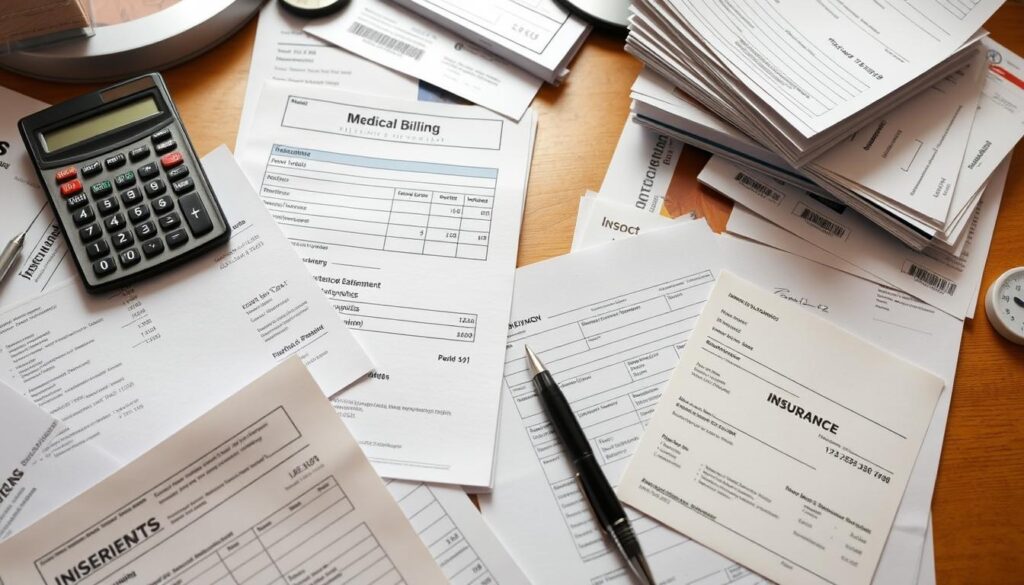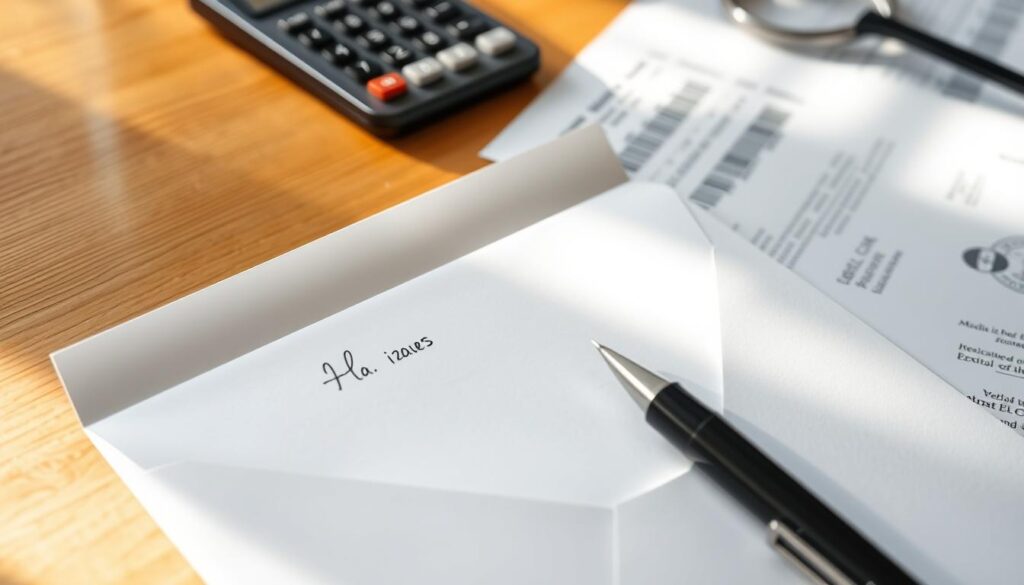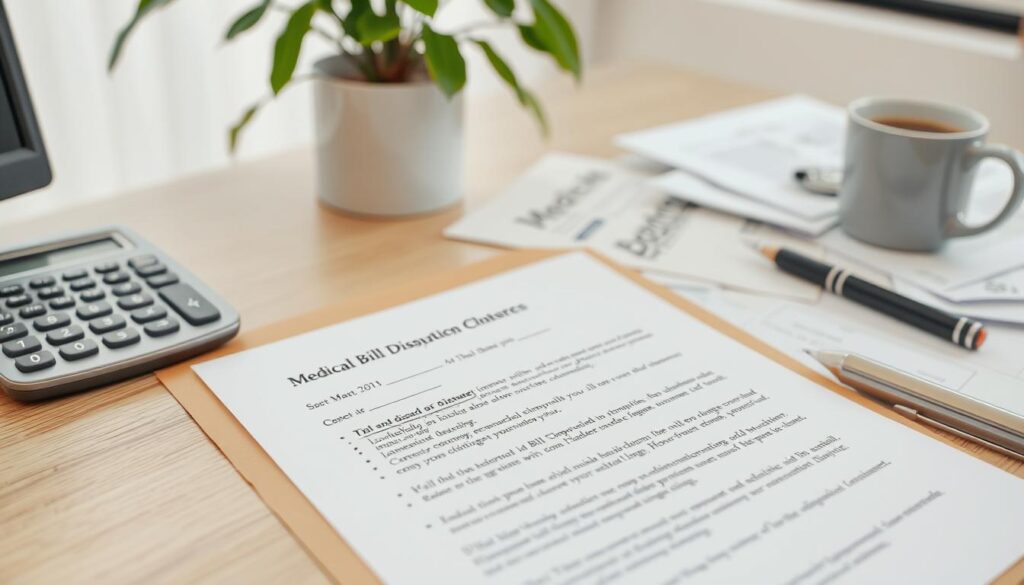Medical billing can be tricky, especially when you spot errors on your hospital bill. It’s important to act quickly when you notice discrepancies. This guide will help you write an effective letter to dispute your medical bill.
You’ll learn how to spot common billing mistakes and review itemized statements. We’ll show you how to craft a compelling dispute letter to negotiate your medical expenses. By following these steps, you can resolve billing issues and prevent future problems.
Key Takeaways
- Understand common medical billing errors and the importance of reviewing itemized statements
- Gather necessary documents and information to prepare your dispute letter
- Craft an effective letter that clearly states the purpose, provides detailed information, and requests corrective action
- Address the letter properly and identify the correct recipient
- Negotiate a resolution and follow up if necessary to ensure the issue is resolved
- Implement proactive strategies to prevent future billing problems
- Utilize patient advocacy resources and healthcare billing practices to your advantage
Understanding Medical Billing Errors
Medical billing can be complex and confusing. It often leads to errors and discrepancies in hospital bills. Patients need to understand common pitfalls to ensure accurate and fair medical statements.
Common Billing Mistakes and Discrepancies
Coding mistakes often result in overbilling. These errors happen when wrong procedure or diagnosis codes are used. Duplicate charges occur when the same service is billed multiple times.
Incorrect insurance coverage calculations can also cause problems. Patients may end up paying more than they should. These issues contribute to inflated medical bills.
The Importance of Reviewing Itemized Statements
Carefully reviewing itemized medical statements is crucial. These detailed breakdowns show services, treatments, and charges. They help identify any hospital bill discrepancies that may have occurred.
By examining these statements, patients can spot potential issues. This allows them to dispute inaccurate or unjustified healthcare billing practices.
“Carefully reviewing your medical bills can save you thousands of dollars in potential overcharges and errors.”
Understanding common medical billing pitfalls is essential. Thoroughly examining itemized medical statements helps prevent overbilling. Patients can protect themselves by actively reviewing their bills.
This approach promotes more transparent and accurate healthcare billing practices. It empowers individuals to address hospital bill discrepancies effectively.
Preparing to Write Your Dispute Letter
Preparing a medical bill dispute letter requires careful gathering of documents and information. This approach strengthens your case and shows your dedication to resolving the issue.
Gathering Necessary Documents and Information
Start by collecting your billing documents. This includes the itemized medical statement, insurance correspondence, and supporting evidence for disputed charges. Organize these neatly to understand the issue clearly.
Collect your medical records to provide context and support your argument. Get copies of relevant medical reports, test results, or treatment notes related to the disputed charges.
- Gather the itemized medical statement
- Collect any insurance correspondence
- Assemble any other supporting evidence
- Obtain copies of relevant medical records
Preparing your documents and information thoroughly equips you to craft a persuasive dispute letter. This attention to detail shows your commitment and increases chances of a favorable outcome.

Crafting an Effective Dispute Letter
A well-structured dispute letter is vital for addressing medical billing concerns. It can help resolve issues quickly and increase your chances of success. Let’s explore how to craft an effective letter.
Start by clearly stating the issue. Provide specific details about the billing error you’ve found. Include the service date, procedure code, and disputed amount. This shows you’ve carefully reviewed the itemized statement.
Outline your desired resolution next. Explain what outcome you’re seeking, whether it’s a correction or charge reduction. This helps the recipient understand your goal clearly.
Maintain a polite yet firm tone throughout your letter. Avoid aggression, as it may hinder the recipient’s willingness to help. Instead, express your concerns professionally and show readiness to work together.
Structure the letter in a clear and organized fashion. Begin with an introduction, then detail the issue and your desired resolution. End with a call to action, requesting a response timeline or action plan.
These guidelines for writing effective medical bill dispute letters can help you structure your dispute letter. A well-crafted letter is a powerful tool for navigating complex medical billing issues.
| Key Elements of an Effective Dispute Letter | Description |
|---|---|
| Clear statement of the issue | Provide specific details about the billing error or discrepancy, including relevant dates, codes, and amounts. |
| Desired resolution | Clearly communicate the outcome you are seeking, such as a correction, reduction, or waiver of the disputed charges. |
| Polite yet firm tone | Express your concerns in a professional and respectful manner, avoiding an aggressive or confrontational approach. |
| Organized structure | Begin with an introductory paragraph, followed by a detailed description and a clear call to action. |
Following these tips for crafting an effective dispute letter can boost your chances of resolving billing issues. It helps ensure you’re not responsible for erroneous or unfair charges.
How To Write A Letter To Dispute A Medical Bill
Challenging a medical bill can feel overwhelming. But don’t worry! With the right approach, you can effectively dispute errors or discrepancies. Let’s explore how to craft a persuasive letter for disputing your medical bill.
Introduction
Start your letter with a clear purpose. Identify the specific bill you’re disputing. Include the service date, provider’s name, and the amount in question.
Describe the Issue
Explain the problem with your medical bill in detail. This could be incorrect charges, duplicate billing, or services not received. Reference any supporting documents to back up your claims.
Use itemized statements or previous correspondence as evidence. These will strengthen your case against the incorrect bill.
Request Corrective Action
Clearly state what action you want the provider to take. This might be correcting the bill, issuing a refund, or removing wrong charges. Be specific in your request and set a deadline for their response.
Addressing the Letter Properly
Correctly addressing your medical bill dispute letter is crucial. Find the right person to handle your concerns efficiently. This step ensures your letter reaches the proper recipient.
Identifying the Correct Recipient
The recipient of your letter depends on the issue and entities involved. You may need to address it to the healthcare provider’s billing department, insurance company, or medical billing company.
Start by checking your medical bill or insurance statement. Look for contact details of the billing department or customer service team. If you can’t find the address, call the provider’s office or insurance company.
| Recipient | Scenario | Contact Information |
|---|---|---|
| Healthcare Provider’s Billing Department | Dispute related to charges, services rendered, or other provider-specific issues | Address and contact details provided on the medical bill or by the provider’s office |
| Insurance Company | Dispute related to coverage, denied claims, or insurance-related matters | Address and contact details provided on the insurance statement or by the insurance company’s customer service |
| Medical Billing Company | Dispute related to billing errors, incorrect coding, or other billing-specific issues | Address and contact details provided by the medical billing company or the provider’s office |
Sending your letter to the right recipient increases your chances of success. It helps address your concerns quickly and effectively. This step is key to resolving your medical bill dispute.

Stating the Purpose of Your Letter
Clearly state the purpose of your letter when disputing a medical bill. This sets the stage for detailed information and corrective action. Your goal is to articulate the specific issue or discrepancy that led to the dispute.
Begin by explaining the state purpose of medical bill dispute letter. Outline the clear reason for disputing medical bill. Be concise and to the point.
- Incorrect billing codes or charges
- Duplicate charges for the same service
- Charges for services not rendered
- Incorrect patient information or insurance coverage details
A clear purpose helps the recipient understand the issue. It prepares them to review supporting documentation and details. This sets the tone for the rest of your communication.
| Key Elements to Include | Example Phrasing |
|---|---|
| Specific issue or discrepancy | I am writing to dispute the medical bill I received for my recent visit to XYZ Hospital on [date]. |
| Clear reason for the dispute | The bill includes charges for a procedure that was not performed during my visit. |
| Request for corrective action | I am requesting that the incorrect charges be removed and a revised, accurate bill be issued. |
A clear purpose statement lays the groundwork for successful dispute resolution. It helps ensure your concerns are addressed promptly and accurately.
Providing Detailed Information
Disputing a medical bill requires detailed information to support your case. Include dates of service, billing codes, and other relevant details. This approach strengthens your argument and helps resolve the issue quickly.
Including Relevant Dates and Billing Codes
Be thorough in your documentation. State the exact dates of medical services and include the corresponding billing codes. This level of detail shows your understanding of the issue.
It also helps the billing department quickly identify the specific charges in question. Your attention to detail can lead to a faster resolution.
- Identify the date(s) of service on the disputed bill.
- Locate the corresponding billing codes (e.g., CPT, HCPCS, or ICD-10 codes) for the services rendered.
- Ensure that the dates and codes are accurately reflected in your dispute letter.
| Date of Service | Billing Code | Description | Disputed Amount |
|---|---|---|---|
| June 15, 2022 | 99213 | Office visit, established patient | $150.00 |
| July 1, 2022 | 81003 | Urinalysis, automated, without microscopy | $35.00 |
Providing this level of detail shows your grasp of the medical billing process. It increases your chances of getting a favorable resolution to your dispute.

Requesting Corrective Action
Disputing a medical bill requires a clear goal. We’ll show you how to request corrective action effectively. Your letter should outline the specific resolution you seek.
Be clear about what you want. This could be a bill reduction, error correction, or charge cancellation. A reasonable request increases your chances of success.
- Clearly state the requested corrective action in your medical bill dispute letter. This could include:
- Reducing the bill by a specific amount
- Correcting a billing error or incorrect charge
- Cancelling the charges entirely
- Provide a justification for your requested resolution, citing specific billing errors or discrepancies that support your case.
- Remain solutions-oriented in your approach, demonstrating a willingness to work with the provider to find a mutually acceptable resolution.
State your desired resolution for medical bill dispute clearly. Offer a strong rationale to boost your chances of success. Be reasonable and direct in your approach.
Focus on finding a solution that works for both parties. This strategy increases the likelihood of a favorable outcome.
| Requested Corrective Action | Justification |
|---|---|
| Reduce the bill by $500 | The lab test was incorrectly coded, resulting in an inflated charge. |
| Cancel the charges entirely | The procedure was not performed, as I was discharged before the scheduled appointment. |
| Correct the billing error for the physical therapy sessions | The number of sessions billed does not match the documented visits in my medical records. |
Follow these guidelines to request corrective action in medical bill dispute letter. You’ll be on track to resolve your dispute and achieve your desired outcome.
Negotiating a Resolution
Effective negotiation is vital in resolving medical bill disputes. By using smart tactics, you can navigate complex billing issues. Your goal is to secure a favorable outcome that works for you.
Strategies for Resolving Billing Disputes
Direct communication with healthcare providers or insurers is crucial. Explain the problem clearly and provide evidence. Be polite but firm when requesting a fair solution.
Don’t hesitate to escalate the dispute if needed. Persistence often pays off in these situations. Remember, your goal is to reach a fair agreement.
Consider exploring payment plans or settlements. Some providers may agree to reduce the balance. Others might offer a more manageable payment schedule if you show commitment.
- Engage in direct communication with the healthcare provider or insurance company
- Provide supporting documentation to substantiate your case
- Explore payment plans or settlements to negotiate a favorable resolution
- Remain persistent and willing to escalate the dispute if necessary
These strategies can help you effectively negotiate your medical bill disputes. They provide a path to a resolution that fits your finances. Remember, fairness should be the guiding principle.
“Negotiating a medical bill dispute requires patience, persistence, and a willingness to advocate for a fair outcome.”

Following Up and Escalating If Necessary
After sending your dispute letter, stay proactive to resolve the issue. Follow up and escalate if needed. This ensures your dispute gets resolved effectively.
Keep track of your dispute’s status. Check with the provider within two weeks to confirm they received your letter. If you don’t hear back, reach out again.
- Request regular updates on the progress of your dispute.
- Politely inquire about the next steps and any additional information they may need from you.
- Document all your follow-up efforts, including the date, time, and the name of the person you spoke with.
If the initial response is unsatisfactory, you may need to escalate the issue. Contact higher-level staff within the provider’s organization. Consider filing a complaint with regulatory authorities.
“Persistence and a willingness to escalate the dispute are key to achieving a favorable resolution in medical bill disputes.”
When escalating, explain the dispute’s history clearly. Provide all supporting documents. Outline the specific actions you want the provider or authorities to take.
Stay professional and polite throughout the process. This increases your chances of a positive outcome. Diligent follow-ups and readiness to escalate can help resolve your medical bill issue.
Preventing Future Billing Issues
Proactive healthcare billing management can help avoid disputes. Simple steps can reduce billing errors and improve your experience with providers. Let’s explore some effective strategies.
Tips for Proactive Healthcare Billing Management
Regularly review your medical statements to prevent future billing issues. Check each item carefully to ensure charges match services received. Address any discrepancies quickly with your provider’s billing department.
Understand your insurance coverage, including deductibles, copays, and out-of-pocket maximums. This knowledge helps you anticipate expenses and spot potential billing errors more easily.
Keep detailed records of your healthcare visits and treatments. Save copies of medical records, receipts, and provider correspondence. These documents can be crucial for resolving any future billing disputes.

